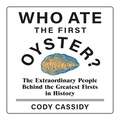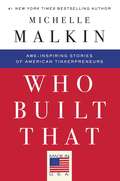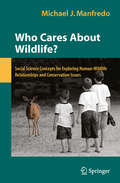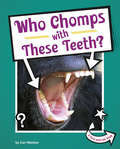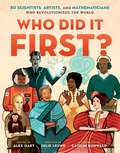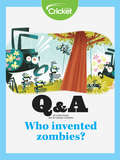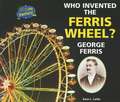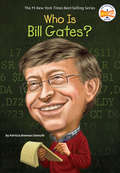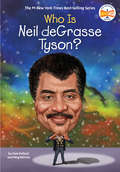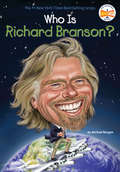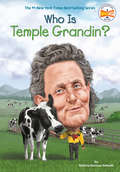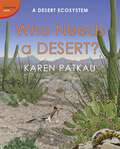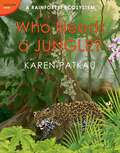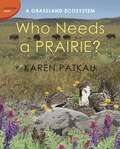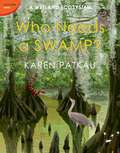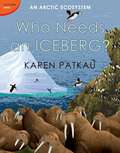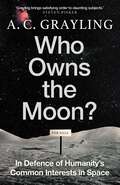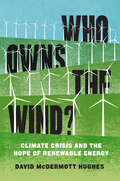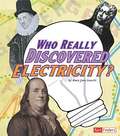- Table View
- List View
Who Ate the First Oyster?: The Extraordinary People Behind the Greatest Firsts in History
by Cody CassidyWho wore the first pants? Who painted the first masterpiece? Who first rode the horse? This madcap adventure across ancient history uses everything from modern genetics to archaeology to uncover the geniuses behind these and other world-changing innovations.In this book, writer Cody Cassidy digs deep into the latest research to uncover the untold stories of some of these incredible innovators (or participants in lucky accidents). With a sharp sense of humor and boundless enthusiasm for the wonders of our ancient ancestors, Who Ate the First Oyster? profiles the perpetrators of the greatest firsts and catastrophes of prehistory, using the lives of individuals to provide a glimpse into ancient cultures to show how and why these critical developments occurred, and educate us on a period of time that until recently we've known almost nothing about.
Who Ate the First Oyster?: The Extraordinary People Behind the Greatest Firsts in History
by Cody CassidyWho wore the first pants? Who painted the first masterpiece? Who first rode the horse? This madcap adventure across ancient history uses everything from modern genetics to archaeology to uncover the geniuses behind these and other world-changing innovations.In this book, writer Cody Cassidy digs deep into the latest research to uncover the untold stories of some of these incredible innovators (or participants in lucky accidents). With a sharp sense of humor and boundless enthusiasm for the wonders of our ancient ancestors, Who Ate the First Oyster? profiles the perpetrators of the greatest firsts and catastrophes of prehistory, using the lives of individuals to provide a glimpse into ancient cultures to show how and why these critical developments occurred, and educate us on a period of time that until recently we've known almost nothing about.(P)2020 Penguin Random House Audio
Who Built That: Awe-Inspiring Stories of American Tinkerpreneurs
by Michelle Malkin<p>Firebrand conservative columnist, commentator, Internet entrepreneur, and #1 <i>New York Times</i> bestselling author Michelle Malkin tells the fascinating, little-known stories of the inventors who have contributed to American exceptionalism and technological progress. <p>In July 2012, President Obama infamously proclaimed: "If you've got a business--you didn't build that. Somebody else made that happen". Malkin wholeheartedly disagrees. <i>Who Built That</i> is a rousing tribute to the hidden American capitalists who pioneered everyday inventions. They're the little big things we take for granted: bottle caps and glassware, tissue paper, flashlights, railroad signals, bridge cables, revolutionary plastics, and more. <p>Malkin takes readers on an eclectic journey of American capitalism, from the colonial period to the Industrial Age to the present, spotlighting awe-inspiring and little-known "tinkerpreneurs" who achieved their dreams of doing well by doing good.</p> <p>You'll learn how famous patent holders Abraham Lincoln and Mark Twain championed the nation's unique system of intellectual property rights; how glass manufacturing mavericks Edward Libbey and Mike Owens defied naysayers to revolutionize food, beverage, and pharmaceutical packaging; how penniless Croatian immigrant Anthony Maglica started his $400 million Maglite flashlight business in a rented garage; and many more riveting stories that explain our country's fertile climate for scientific advancement and entrepreneurship. <p>To understand who we are as people, we need to first understand what motivates America's ordinary and extraordinary makers and risk-takers. Driven by her own experience as a second-generation beneficiary of the American Dream, Malkin skillfully and passionately rebuts collectivist orthodoxy to celebrate the engineers, mechanics, designers, artisans, and relentless tinkerers of all backgrounds who embody our nation's spirit of self-made entrepreneurialism.</p>
Who Cares About Wildlife?
by Michael J. ManfredoWho Cares About Wildlife? integrates social science theory in order to provide a conceptual structure for understanding and studying human interaction with wildlife. A thorough review of the current literature in conceptual areas, including norms, values, attitudes, emotions, wildlife value orientations, cultural change, and evolutionary forces/inherited tendencies is provided, and the importance of these areas in studying human-wildlife relationships is highlighted. No other book both considers the human relationship with wildlife and provides a theoretical framework for understanding this relationship on the individual, as well as cultural level. Who Cares About Wildlife? will be valuable both to students and to practitioners in wildlife management and conservation, as well those interested in the human relationship with wildlife, natural resources, and the environment.
Who Chomps With These Teeth? (Whose Is This?)
by Cari MeisterChomp! This photo-guessing game challenges kids to guess whose teeth are in the images. The dazzling, jagged, and razor-sharp answers may be surprising!
Who Did It First? 50 Scientists, Artists, and Mathematicians Who Revolutionized the World: 50 Scientists, Artists, And Mathematicians Who Revolutionized The World (Who Did It First? #1)
by Julie LeungA boldly illustrated and fascinating collection of profiles featuring the women and men who were pioneers of science, technology, engineering, the arts, and mathematics.You likely know that Mae Jemison was the first African American woman in space. And maybe you know that Jane Goodall was the first human accepted into a chimpanzee community. But you might not know that Alan Turing was the first person to introduce the concept of artificial intelligence. Or that Tu Youyou was the first Chinese woman to win a Nobel Prize. Who Did It First? 50 Scientists, Artists, and Mathematicians Who Revolutionized the World brings together all of these trailblazers into one stunning package. With both well-known figures and lesser-known heroes, editor Alex Hart, writer Julie Leung, and illustrator Caitlin Kuhwald celebrate the inspiring innovators who braved uncharted waters to pave the path for future generations.Perfect for fans of Little Leaders, Women in Science, and Rad Women Worldwide, Who Did It First? makes a wonderful gift for any occasion and is a must-have for every young reader’s library.Featuring Ada Lovelace, Mindy Kaling, Temple Grandin, Maria Tallchief, Riz Ahmed, and many others.
Who Hears With These Ears? (Whose Is This?)
by Cari MeisterGrrr! This photo-guessing game challenges kids to guess whose ears are in the images. The furry, floppy, and finely-tuned answers may be surprising!
Who Invented Zombies?
by Lizzie WadeZombies have become a staple in pop culture. But where did the idea of zombies come from? According to biologist David Hughes, the culprit is nature itself.
Who Invented the Ferris Wheel? George Ferris (I Like Inventors!)
by Sara L. LattaRead about George Ferris, and how he invented the ferris wheel.
Who Is Bill Gates? (Who was?)
by Nancy Harrison Patricia Brennan Demuth Ted HammondBill Gates, born in Seattle, Washington, in 1955, is an American business magnate, investor, philanthropist, and author. In this Who Was...? biography, children will learn of Gates' childhood passion for computer technology, which led him to revolutionize personal computers. Through the success of his now-world-famous software company, Microsoft, Bill Gates became one of the wealthiest philanthropists in history.This fascinating story of a child technology genius is sure to captivate all audiences!
Who Is Knowledgeable Is Strong: Science, Class, and the Formation of Modern Iranian Society, 1900-1950
by Cyrus SchayeghCyrus tells two intertwined stories: how, in early 20th-century Iran, an emerging middle class used modern scientific knowledge as its cultural and economic capital, and how, along with the state, it employed biomedical sciences to tackle presumably modern problems.
Who Is Neil deGrasse Tyson? (Who Was?)
by Pam Pollack Meg Belviso Who HQDiscover how Neil deGrasse Tyson became one of the world&’s most successful and well-known scientists in this new addition to the #1 New York Times bestselling series.When he was nine years old, Neil deGrasse Tyson went on a trip that would change his life. While visiting the Hayden Planetarium at the Museum of Natural History in New York City, he discovered the world of astronomy and felt like the universe was calling to him. He answered that call by diving deep into astronomy courses. After graduating from the Bronx High School of Science, he went on to earn a doctorate in astrophysics and eventually found his way back to the Hayden Planetarium as a staff scientist and, later, as its director. Neil has not only found an exciting way to share his love and knowledge of space through his documentaries and podcasts, he&’s also broken barriers for Black scientists and become one of the most famous astrophysicists ever. He is a published author, television host, and winner of the prestigious Public Welfare Medal for the role he has played in exciting the public about the wonders of science.
Who Is Richard Branson? (Who Was?)
by Michael Burgan Ted HammondWhat would you do with a billion dollars? This question gets a definitive answer from billionaire Richard Branson: do everything! Born into a wealthy family in London, Branson suffered from dyslexia and was a poor student. Still, his knack for business started early with a successful parakeet-breeding enterprise at age 11.The charismatic entrepreneur launched his first major business, Virgin Records, at age 22 and spent the next few decades building the Virgin group that now includes more than 400 companies. Known for his eccentric lifestyle and trillion-watt smile, Branson's hot air balloon flights, innovative leadership, and world record attempts have made him an instantly-recognizable global icon.
Who Is Temple Grandin? (Who Was?)
by Patricia Brennan Demuth Who HQAutism did not stop her--in fact, it helped Temple Grandin become a brilliant scientist and inventor.Temple Grandin wasn't officially diagnosed with autism until she was in her 40s, but she knew at an early age that she was different from her family and classmates. She couldn't show affection, she acted out when noises or other stimuli overwhelmed her, and she only felt comfortable when spending time with the animals on her aunt's ranch. But instead of seeing her differences as limitations, Temple used them to guide her education and career in animal science. She has become a leading advocate for the autistic as well as for the humane treatment of animals at meat packing companies. This inspiring biography by Patricia Brennan Demuth shines a light on Temple Grandin's intellect, creativity, and unique spirit.
Who Needs a Desert?: A Desert Ecosystem (Ecosystem Series)
by Karen PatkauKaren Patkau takes readers on an amazing voyage of discovery to find out • How deserts are formed • Where deserts are found • How plants and animals adapt to the severe environment • What wildlife thrives there • Which plants bloom under the blazing sun • How desert plants and animals get energy and food • What happens in the rainy seasons • Why desert land becomes barren • Why we need deserts
Who Needs a Jungle? (Ecosystem Series)
by Karen PatkauTundra introduces the first three books in its important new ecosystems series. Each title celebrates the world&’s diversity by presenting a different ecosystem: its land and water, its animals and plants. The art is brimming with creatures and ecological features, described in fact-filled notes at the end of each book and in a useful glossary and map. Jungles are treasures for all of us, regardless of where we live. In Who Needs a Jungle? we learn about its vital role in providing us with oxygen, food, medicinal ingredients, and raw materials we use every day. Not only is each book informative and beautiful, but it is a call to action for everybody who cares about the world in which we live.
Who Needs a Prairie?: A Grassland Ecosystem (Ecosystem Series)
by Karen PatkauKaren Patkau takes readers on an amazing voyage of discovery to find out • How wild and rugged prairies become grasslands • Why prairie inhabitants depend on each other and their surroundings • What wildlife and plants thrive in large open spaces • How seasons and weather conditions affect life on the prairies • How fire restores the land • What life is like on the Great Plains • How a food chain forms • How some prairie plants protect the land • Why we need prairies
Who Needs a Reef?: A Coral Reef Ecosystem (Ecosystem Series)
by Karen PatkauKaren Patkau takes readers on an amazing voyage of discovery to find out • How coral reefs form • Why coral reefs bustle and teem with life • Why there are more kinds of living things on coral reefs than anywhere else in the sea • What the types of hard corals are • Which plants and animals attach themselves to coral reefs • How coral reefs protect shorelines • How coral reefs help develop natural harbors and beaches • Where the coral reef areas of the world are • Why we need coral reefs
Who Needs a Swamp? (Ecosystem Series)
by Karen PatkauTundra introduces the first three books in its important new ecosystems series. Each title celebrates the world&’s diversity by presenting a different ecosystem: its land and water, its animals and plants. The art is brimming with creatures and ecological features, described in fact-filled notes at the end of each book and in a useful glossary and map. Swamps are often seen as a dangerous and useless. They are often drained to create farmland or to reduce diseases. But such measures can be disastrous. Who Needs a Swamp? explores wetlands and their importance in the food chain and in preserving our soil and clean water. Not only is each book informative and beautiful, but it is a call to action for everybody who cares about the world in which we live.
Who Needs an Iceberg? (Ecosystem Series)
by Karen PatkauTundra introduces the first three books in its important new ecosystems series. Each title celebrates the world&’s diversity by presenting a different ecosystem: its land and water, its animals and plants. The art is brimming with creatures and ecological features, described in fact-filled notes at the end of each book and in a useful glossary and map. Who Needs an Iceberg? The Arctic ecosystem is changing rapidly. The Arctic Ice Cap is melting, the habitat for the creatures that live in the north is shrinking, and the earth is warming up. The impact is enormous for all of us.Not only is each book informative and beautiful, but it is a call to action for everybody who cares about the world in which we live.
Who On Earth is Archie Carr: Protector of Sea Turtles
by Christine WebsterDetails Archie Carr's life, with chapters devoted to his early years, life, work, writings, and lasting contributions.
Who Owns the Dead?
by Jay D. AronsonAfter the 9/11 attack on the World Trade Center, Chief Medical Examiner Charles Hirsch proclaimed that his staff would do more than confirm the victims' identity. They would attempt to return to families every human body part larger than a thumbnail. As Jay D. Aronson shows, delivering on that promise proved to be a monumentally difficult task.
Who Owns the Moon?: In Defence of Humanity's Common Interests in Space
by A. C. GraylingSilicon for microchips; manganese for batteries; titanium for missiles. The moon contains a wealth of natural resources. So, as the Earth&’s supplies have begun to dwindle, it is no surprise that the world&’s superpowers and wealthiest corporations have turned their eyes to the stars. As this new Space Race begins, A.C. Grayling asks: who, if anyone, owns the moon? Or Mars? Or other bodies in near space? And what do those superpowers and corporations owe to Planet Earth and its inhabitants as a whole? From feudal common land, through the rules of the sea, to the vast, nationless expanse of Antarctica, Grayling explores the history of the places which no one, and therefore everyone, owns. Examining the many ways this so-called terra nullius has fallen victim to &‘the tragedy of the commons&’ – the tendency for communal resources to be exploited by a few individuals for personal gain at the expense of everyone else – Who Owns the Moon? puts forward a compelling argument for a bold new global consensus, one which recognises and defends the rights of everyone who lives on this planet.
Who Owns the Wind?: Climate Crisis and the Hope of Renewable Energy
by David McDermott HughesWhy the wind, and energy it produces, should not be private propertyThe energy transition has begun. To succeed—to replace fossil fuels with wind and solar power—that process must be fair. Otherwise, mounting pop- ular protest against wind farms will prolong carbon pollution and deepen the climate crisis. David McDermott Hughes examines that anti-industrial, anti- corporate resistance, drawing on his time spent conducting field research in a Spanish village surrounded by wind turbines. In the lives of a community freighted with centuries of exploitation—people whom the author comes to know intimately—clean power and social justice fit together only awkwardly. A green economy will require greater efforts to get ordinary people such as these on board. Aesthetics, livelihood, property, and, most essentially, the private nature of wind resources—all these topics must be examined with fresh eyes.
Who Really Discovered Electricity? (Race for History)
by Amie Jane LeavittFollows the stories of Dr. William Gilbert, Stephen Gray, and Benjamin Franklin as they explore the force now called electricity.

